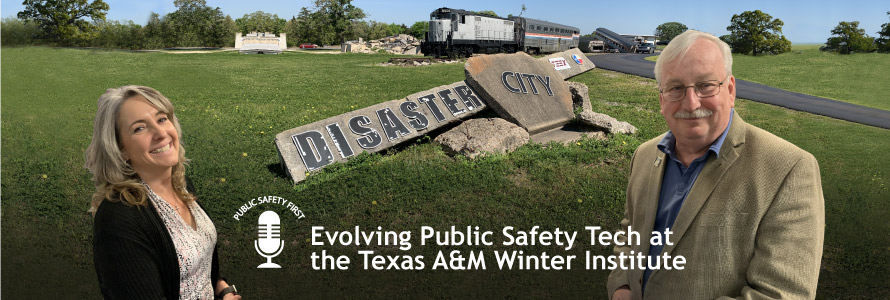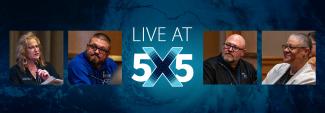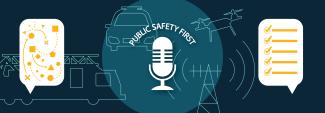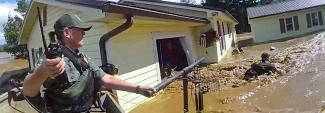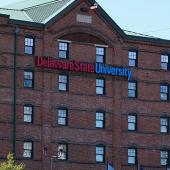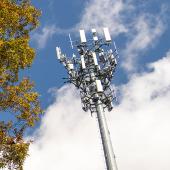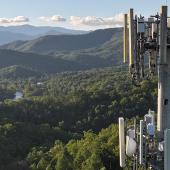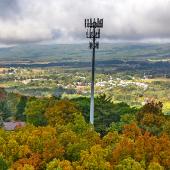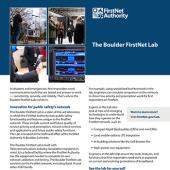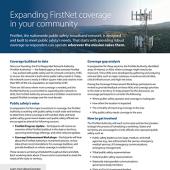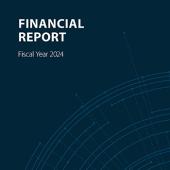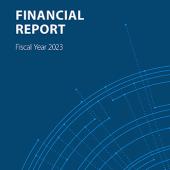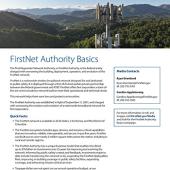Summary
The Texas A&M Internet2 Technology Evaluation Center (ITEC) in College Station, Texas plays an important role in developing public safety broadband technologies. Through its annual Winter Institute Workshop and Exercise, ITEC has brought together industry and public safety leaders to test and developing apps and services that benefit first responders.
Guest
Jacque Miller-Waring
FirstNet Authority Area Director for the Midwest Region
Walt Magnussen
Director, Texas A&M Internet2 Technology Evaluation Center
Transcript
Preview
Narrator: You're listening to Public Safety First, a podcast to help you learn about the First Responder Network Authority and how you can be part of the future of public safety technology.
Jacque Miller-Waring: I’m Jacque Waring. I’m with the First Responder Network Authority, and I’m here today with Walt Magnussen of Texas A&M’s Internet2 Technology Evaluation Center, and we’re going to talk a little bit about Winter Institute and some history with Walt and a lot of the things that he’s done over the last, well, few years, we’ll say. Can you just tell us a little more about your background and what your current role is?
Narrator: You're listening to Public Safety First, a podcast to help you learn about the First Responder Network Authority and how you can be part of the future of public safety technology.
Jacque Miller-Waring: I’m Jacque Waring. I’m with the First Responder Network Authority, and I’m here today with Walt Magnussen of Texas A&M’s Internet2 Technology Evaluation Center, and we’re going to talk a little bit about Winter Institute and some history with Walt and a lot of the things that he’s done over the last, well, few years, we’ll say. Can you just tell us a little more about your background and what your current role is?
Walt Magnussen: Thanks, Jacque, and it’s an honor being here today. Been with Texas A&M University for 35 years now, and since 2004, I’ve been directing a center referred to as the Internet2 Technology Evaluation Center. We’re a center that was originally created to work mainly in real-time communications space, but shortly after we got started, we got involved with the FCC [Federal Communications Commission] and with NENA – the National Emergency Number Association – and started working in public safety communications. It’s where we got started with this stuff, and been there ever since.
Jacque Miller-Waring: How have you seen the landscape of communications change during your career – 35 years, that’s quite a span of time for us to be thinking about, but how has communications changed over the years, and then specifically within the last five years?
Walt Magnussen: The technology’s changed an awful lot in the areas of standardization of product, so, whereas we were operating on standalone systems that did not interoperate in the past, now things have gone to, for example, in the voice space, to SIP [Session Initiation Protocol]-based communications, and the wireless, it’s all been transitioning into the LTE [long-term evolution] space. And so what we’re really seeing is fantastic opportunities in interoperability. The devices have become more and more powerful; the applications are more enabled, and a lot of them are using services that can be shared, so it’s very, very easy to develop new apps. Whereas in the past, you pretty much would have to develop the entire protocol stack. Now you can count on and utilize modules from other systems and bring them together and come up with a really awesome package in a relatively short period of time. So, it’s standardization of the product, standardization of the services that’s got us to unlimited capabilities.
Jacque Miller-Waring: So, we’ll talk a little bit more about FirstNet in particular, and I know that you have a deep history with FirstNet. So, if you could talk a little bit about your involvement with public safety broadband and your work in getting to where we are today with a nationwide public safety broadband solution.
Walt Magnussen: So, around 2010, Harris County [Texas] – which is Houston-area – Harris County received funding from FEMA [Federal Emergency Management Agency] to build the first public safety broadband network in the country. It was funded by FEMA after a hurricane. It was kind of the start of things. That’s when the FCC was really looking at trying to figure out where to go. Then, of course, in 2012, Congress passed the First Responders Network Authority, or FirstNet, legislation, and at that time, the idea and the goal was, which they’re doing, is to go ahead and create a single network in the country that has the ability to support and service first responders that has different capabilities than the commercial network. So, with the Harris County project, they located their core here in Bryan-College Station at Texas A&M University. We use the Internet2 backbone to get from College Station down to Houston, so we’re very, very much involved in the initial design. Right across the street from us is our Rudder Theatre Complex. It’s a 12-story building and probably the tallest area in Brazos County, so we had three of the initial nodes in there. After the inception of FirstNet, with the awarding of the contract to AT&T, there were a few of what they referred to as the “Early Adopters” that were out there. One of the Early Adopters was Harris County as a FirstNet Early Adopter, and in that we were given some key learning conditions – what happens if I go into high power mode, extended mode, so our key learning conditions we all had responsibilities to feed information back into FirstNet. So, we were part of the early development process.
More recently, we’ve been working on the application and services space. The network is really pretty well defined, pretty well running, and there’s not as much work that we can really do in the network space. But, there is a lot of work that we can do in the application and services space. So, that’s really where we’ve been focusing our efforts for probably the last four, five years.
Jacque Miller-Waring: So, that leads into what we’re here for today, right? We’re all here for Winter Institute. If you could describe Winter Institute and how it’s evolved over the last few years, and the focus of that now.
Walt Magnussen: So, the Winter Institute started about five, six, seven years ago. We’ve done five of them so far, and the early concept of it was we were working with one of our professors here, Dr. Robin Murphy, and she had a Summer Institute, and the focus of the Summer Institute was on drones, on UAS [unmanned aircraft system] devices, and, so, she did the UAS focus, and we brought in the network to support. Well, we came up with the idea then, well, why don’t we maybe do a network-centric exercise, and let’s go ahead and – so, that became the Winter Institute. Each year we utilize a scenario that we work with public safety, first responders, to actually bring out devices, bring out services and test them, get feedback from the first responders, so the vendor community that supports us can look at it and say, “Yeah, this needs to be modified.” The first responders can say, “That’s the stupidest idea I’ve ever seen, but if you would change it, it would be able to do this for us.” One vendor about three years ago completely redefined or completely rewrote their user interface after one of the Winter Institutes because it was looking at some radiological detection equipment, and Texas Task Force 1 looked at it and said, “That’s not really the way we look at things.” So, they sat down together and talked, and they’re going, “Ah, you know, that makes sense.” So, those are the kind of things we try to bring together. We utilize a place called Disaster City. It’s several hundred acres of training facilities that they train about, last year was 195,000 first responders, and we have buildings that they burn, collapsed bridges, derailed trains, underground tunnels, buildings that they climb, and abandoned warehouses and stuff like that, that are all part of the training facility. So, we bring in the first responders and they become part of the props, but then we also bring in the network, and then the network becomes the services on top of that, and the first responders get together, write the exercise, write the scenario, and then out of that we then develop the after action reports.
Jacque Miller-Waring: So, a lot of the information that we’re getting out of Winter Institute feeds back into the vendor community, feeds back into emerging technologies and those types of things. So, from your perspective, where do you see communications going in the next decade?
Walt Magnussen: We’ve done a lot of standardization, but we still have a whole lot more to go. When you look at things like the implementation of NG9-1-1 [Next Generation 9-1-1], we’re still probably only, my guess is somewhere around five, ten percent of that is done nationwide. And that’s money that most local entities don’t have sitting in their back pockets right now. Things like the ICAM [Identity, Credential, and Access Management], the authorization identification process, everybody’s doing that themselves right now, and in a world where you’ve got FirstNet and you’ve got first responders coming in and you want to be able to share information, we need to be able to figure out how to share that information and allow incoming users to be able to utilize our services.
The Bastrop fires here a number of years ago, that’s one of the biggest fires in the state of Texas. We had first responders from all 50 states here working with us. So, you can imagine responders, first responders coming in from 50 states, and we need to somehow share maps of what’s going on. If you can imagine, the fire’s coming through rapidly and we’re evacuating people. It’s hard to really figure out which buildings have been inspected when you’ve got all these people from all these different agencies and no common communications platform. So, the standardization, we’re basically still at the infancy in that space, but the first thing we’ve got to really do is figure out what’s the low hanging fruit? What do we prioritize first, what are the areas that are going to give us the most benefit? Because overall, this is going to take ten, fifteen, twenty years to get it all done, and we can’t really wait until it’s all completed. We need to take small steps, but then benefit from the small steps as we do them.
Jacque Miller-Waring: We talked a little bit today about a briefing that you did regarding 5G – could you talk a little bit more about that and what your interest is and your passion for 5G and where it’s going and where we’re going with that technology?
Walt Magnussen: So, we received eight million dollars funding from the state of Texas to build a 5G, what we refer to as the Innovation Proving Ground. The Innovation Proving Ground was funded to support Department of Defense, public safety, transportation, and things like that. So, we all hear an awful lot about 5G, about the deployments being nationwide, this, that, and the other. The reality is, that’s great, and we know there’s going to be a lot of capabilities added to the system, to the networks as they come about, but it’s not as effective, it’s not as efficient if we wait until the network’s here and then figure out how to use it. So, part of the process, or part of the concept of the Innovation Proving Ground is to put a private 5G network together that we can manage, we can manipulate, we can go ahead and understand what’s going on underneath the sheets, so that when it is ubiquitous across the United States, we already know what we’re doing with it. We’re not trying to figure it out then. My guess is we’ll probably be able to save two, three years off of the process by doing that. There’s a number of areas, such as 4K video and things like that that you really can’t support on 4G networks today. So, if we have the ability to do that – you know, the questions we have to ask are do we really need that? If we do need it, what are we going to use it for? If we do use it, how are we going to get and store the information? Those are things we can be looking at now and not waiting until it’s available in a store near you.
We have high respect, high regard, high level of involvement with the public safety community. And, quite frankly, they’re great folks. I mean, anything that we can do to help support them makes all of us safer. The services that we’re doing are leading edge, but we need to figure out how to get these services in the hands of the first responders sooner rather than later.
Jacque Miller-Waring: Great, thank you.
Walt Magnussen: Thank you.
Narrator: Thanks for listening today. We're excited to have you join our podcast community. Make sure to subscribe on iTunes, SoundCloud, and YouTube. You can learn more about the First Responder Network Authority at FirstNet.gov and learn about FirstNet products and services at FirstNet.com.


